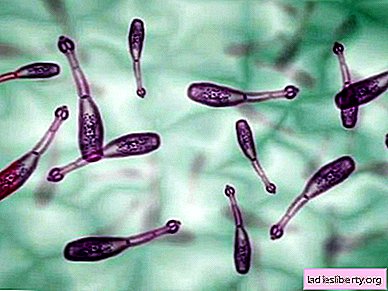
Echinococcosis is a rare parasitic disease with a chronic course, which occurs as a result of exposure to the body of the larval form of Echinococcus granulosus - tape helminth. Under the influence of these parasites, single-chamber or multi-chamber parasite bubbles develop in the human body and the activity of the organs in which they developed develops.
Most often, helminths are localized in the liver and lungs, however, they can also develop in other organs (brain, kidneys, heart), often due to the development of metastases. Echinococcosis can lead to serious complications, up to disability and death. The number of complications in this disease reaches 30%. Of these, the most severe consequences are rupture of the cyst, which can lead to a blow, weight lifting, rough palpation. Cyst rupture is manifested by a sharp pain syndrome, its consequences can be an allergic reaction of varying severity and even anaphylactic shock.
Echinococcosis - causes
The main source of the disease for humans is domestic dogs, with the feces of which mature eggs of the parasites are secreted. They pollute their coat and environment. A person becomes infected by contacting infected animals, or picking berries and herbs, or using water from contaminated sources.
Echinococcosis - symptoms
Symptoms of the disease are determined by the number, size and localization of echinococcal blisters. The most common are echinococcosis of the liver (they make up from 60% to 80% of diseases). Echinococcosis of the liver in the initial stages is manifested by severity and moderate intermittent pain in the right hypochondrium, sometimes by urticaria (due to allergization). In subsequent stages, the disease is manifested by enlarged liver, ascites, edema, jaundice.
Echinococcosis of the lungs is manifested by persistent dry cough, hemoptysis, pain in the chest. Cases of echinococcosis of other organs are rare, and they have symptoms similar to manifestations of neoplasms.
Echinococcosis - diagnosis
For the diagnosis of the disease, data from an epidemiological history, analysis of clinical and radiological signs, results of allergological (Casoni reaction) and serological tests, examination of sputum and pleural fluid (with the appearance of a cyst in the pleural cavity) are used. Also, diagnosis can be supplemented by serological methods to detect antibodies to echinococcus IgG classes.
When conducting a clinical examination of a patient, the doctor must remember that rough palpation of the wall of the developed parasitic bladder can lead to its rupture and unpredictable consequences. Echinococcal bladder puncture is possible only after laparotomy.
Echinococcosis - treatment and prevention
Echinococcus can be removed only by surgical intervention. The operation may be of the form:
- radical echinococcectomy with complete removal of the echinococcal cyst, which is called the "hydatide";
- opening the cyst, removing the fluid, hydatide and membrane, after which the cavity formed is sutured tightly.
The prognosis for this disease is determined by the location of the cyst, as well as the presence or absence of them in other organs and the general condition of the patient. A patient who has had echinococcosis needs follow-up, which should last at least 8 years.
Prevention of echinococcosis consists in the proper organization of sanitary control in slaughterhouses; the exclusion of the possibility of using the organs of animals that are affected by echinococcus for feeding dogs; veterinary supervision of dogs, especially domestic, and compliance with the rules of personal hygiene in their maintenance.











